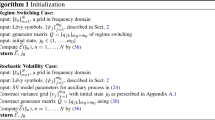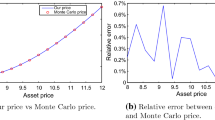Abstract
This paper proposes a unified approach for pricing discretely monitored floating and fixed strike Asian options under a broad class of regime-switching and stochastic volatility models with jumps. The randomness in volatility can be either characterized by regime switching among discrete market states, a diffusive stochastic variance process correlated with the underlying asset price, or a random time change applied to a background process. Our approach can be applied to price financial derivatives with exotic averaging type payoffs, which goes beyond most of the existing frameworks in terms of versatility. Our success relies on the adoption of the change-of-measure approach and a dimension reduction technique. Specifically, we construct new backward recursions for Asian options that include floating and fixed strike payoffs under a wide range of regime-switching and stochastic volatility models with jumps. The Fourier-cosine series expansion and Gauss quadrature rule are applied to solve the backward recursions. The exponential convergence rate of our approach is proven theoretically and verified numerically via comprehensive error analysis. Extensive numerical experiments demonstrate that our approach is reliable, accurate, and efficient.


Similar content being viewed by others
Availability of Data and Materials
The datasets generated during and/or analysed during the current study are available from the corresponding author upon request.
Notes
As shown in [36], the computations under the 3/2 model with/without jumps are dominated by the calculations of the modified Bessel functions of the first kind with complex orders at the preparation step, and GPU programming is not beneficial to this step. Accordingly, the decrease in the computational time is not as significant as those under other models.
References
Andreasen, J.: The pricing of discretely sampled Asian and lookback options: a change of numeraire approach. J. Comput. Finance 2(1), 5–30 (1998)
Bates, D.S.: Jumps and stochastic volatility: exchange rate processes implicit in Deutsche mark options. Rev. Financ. Stud. 9(1), 69–107 (1996)
Boyd, J.P.: Chebyshev and Fourier Spectral Methods, 1st edn. Springer-Verlag, Berlin Heidelberg (1989)
Broadie, M., Glasserman, P.: Estimating security price derivatives using simulation. Manag. Sci. 42(2), 269–285 (1996)
Cai, N., Song, Y., Kou, S.: A general framework for pricing Asian options under Markov processes. Oper. Res. 63(3), 540–554 (2015)
Carr, P., Wu, L.: Time-changed Lévy processes and option pricing. J. Financ. Econ. 71(1), 113–141 (2004)
Černý, A., Kyriakou, I.: An improved convolution algorithm for discretely sampled Asian options. Quant. Finance 11(3), 381–389 (2011)
Chen, Z., Feng, L., Lin, X.: Inverse transform method for simulating Lévy processes and discrete Asian options pricing. In: Proceedings of the 2011 Winter Simulation Conference, pp. 444–456 (2011)
Chen, Z., Feng, L., Lin, X.: Simulating Lévy processes from their characteristic functions and financial applications. ACM Trans. Model. Comput. Simul. 22(3), 1–26 (2012)
Corsaro, S., Kyriakou, I., Marazzina, D., Marino, Z.: A general framework for pricing Asian options under stochastic volatility on parallel architectures. Eur. J. Oper. Res. 272(3), 1082–1095 (2019)
Cui, Z., Nguyen, D.: First hitting time of integral diffusions and applications. Stoch. Model. 33(3), 376–391 (2017)
Dingeç, K.D., Sak, H., Hörmann, W.: Variance reduction for Asian options under a general model framework. Rev. Finance 19(2), 907–949 (2015)
Drimus, G.G.: Options on realized variance by transform methods: a non-affine stochastic volatility model. Quant. Finance 12(11), 1679–1694 (2012)
Eberlein, E., Papapantoleon, A.: Equivalence of floating and fixed strike Asian and lookback options. Stoch. Processes Appl. 115(1), 31–40 (2005)
Fang, F., Oosterlee, C.W.: A novel pricing method for European options based on Fourier-cosine series expansions. SIAM J. Sci. Comput. 31(2), 826–848 (2009)
Fang, F., Oosterlee, C.W.: Pricing early-exercise and discrete barrier options by Fourier-cosine series expansions. Numer. Math. 114(1), 27–62 (2009)
Fang, F., Oosterlee, C.W.: A Fourier-based valuation method for Bermudan and barrier options under Heston’s model. SIAM J. Financ. Math. 2(1), 439–463 (2011)
Fusai, G., Kyriakou, I.: General optimized lower and upper bounds for discrete and continuous arithmetic Asian options. Math. Oper. Res. 41(2), 531–559 (2016)
Geman, H., Yor, M.: Bessel processes, Asian options, and perpetuities. Math. Financ. 3(4), 349–375 (1993)
Henderson, V., Wojakowski, R.: On the equivalence of floating- and fixed-strike Asian options. J. Appl. Probab. 39(2), 391–394 (2002)
Heston, S.L.: A closed-form solution for options with stochastic volatility with applications to bond and currency options. Rev. Financ. Stud. 6(2), 327–343 (1993)
Heston, S.L.: A simple new formula for options with stochastic volatility. Working paper of Olin School of Business, Washington University (1997)
Kemna, A.G.Z., Vorst, A.C.F.: A pricing method for options based on average asset values. J. Bank. Finance 14(1), 113–129 (1990)
Kirkby, J.L.: An efficient transform method for Asian option pricing. SIAM J. Financ. Math. 7(1), 845–892 (2016)
Kirkby, J.L., Nguyen, D.: Efficient Asian option pricing under regime switching jump diffusions and stochastic volatility models. Ann. Finance 16(3), 307–351 (2020)
Leitao, Á., Ortiz-Gracia, L., Wagner, E.I.: SWIFT valuation of discretely monitored arithmetic Asian options. J. Comput. Sci. 28, 120–139 (2018)
Levendorskiĭ, S.: Pricing arithmetic Asian options under Lévy models by backward induction in the dual space. SIAM J. Financ. Math. 9(1), 1–27 (2018)
Levendorskiĭ, S., Xie, J.: Pricing of discretely sampled Asian options under Lévy processes. Available at SSRN: https://ssrn.com/abstract=2088214 (2012)
Linetsky, V.: Spectral expansions for Asian (average price) options. Oper. Res. 52(6), 856–867 (2004)
Ruijter, M.J., Oosterlee, C.W.: Two-dimensional Fourier cosine series expansion method for pricing financial options. SIAM J. Sci. Comput. 34(5), B642–B671 (2012)
Večeř, J.: A new PDE approach for pricing arithmetic average Asian options. J. Comput. Finance 4(4), 105–113 (2001)
Yamazaki, A.: Pricing average options under time-changed Lévy processes. Rev. Deriv. Res. 17(1), 79–111 (2014)
Zeng, P., Kwok, Y.K.: Pricing bounds and approximations for discrete arithmetic Asian options under time-changed Lévy processes. Quantit. Finance 16(9), 1375–1391 (2016)
Zhang, B., Oosterlee, C.W.: Efficient pricing of European-style Asian options under exponential Lévy processes based on Fourier cosine expansions. SIAM J. Financ. Math. 4(1), 399–426 (2013)
Zhang, G., Li, L.: Analysis of Markov chain approximation for option pricing and hedging: grid design and convergence behavior. Oper. Res. 67(2), 407–427 (2019)
Zhang, W., Zeng, P.: A transform-based method for pricing Asian options under general two-dimensional models. Quantit. Finance 23(11), 1677–1697 (2023)
Zhang, W., Zeng, P., Kwok, Y.K.: Efficient recursion-quadrature algorithms for pricing Asian options and variance derivatives under stochastic volatility and Lévy jumps. Oper. Res. Lett. 51(6), 687–694 (2023)
Acknowledgements
Pingping Zeng acknowledges the support of the National Natural Science Foundation of China (Grant Nos. 12171228 and 11701266). The research of Gongqiu Zhang was supported by the Shenzhen Fundamental Research Program Project (Grant No. JCYJ20190813165407555) and the National Natural Science Foundation of China (Grant Nos. 12171408 and 11801423).
Author information
Authors and Affiliations
Corresponding authors
Ethics declarations
Conflict of interest
We have no conflicts of interest to disclose.
Additional information
Publisher's Note
Springer Nature remains neutral with regard to jurisdictional claims in published maps and institutional affiliations.
Appendices
Proof of Proposition 3.1
To prove Proposition 3.1, we need an extension of Lemma 3.1, the details of which are stated as follows:
Lemma A.1
Under regime-switching Lévy models, SV models with Lévy jumps, and time-changed Lévy models considered in Sect. 2, for any \(n\in {\mathbb {N}}\) and \(0\le s_0<\cdots <s_n\), under the probability measure \(\overline{{\mathbb {Q}}}\) specified in Eq. (3.3), the joint distribution of \((Y_{s_1}-Y_{s_0},\ldots ,Y_{s_n}-Y_{s_0})\) given \((Y_{s_0},v_{s_0})\) depends only on \(v_{s_0}\).
Proof
Under \(\overline{{\mathbb {Q}}}\), the joint characteristic function of \((Y_{s_1}-Y_{s_0},\ldots ,Y_{s_n}-Y_{s_0})\) conditional on \((Y_{s_0},v_{s_0})\) satisfies
where \({\overline{w}}_n=w_n-\textrm{i}\) and \({\overline{w}}_k=w_k\) for \(k=1,\ldots ,n-1\) when \(n\ge 2\). Applying Lemma 3.1, we can conclude that under \(\overline{{\mathbb {Q}}}\), the joint characteristic function of \((Y_{s_1}-Y_{s_0},\ldots ,Y_{s_n}-Y_{s_0})\) conditional on \((Y_{s_0},v_{s_0})\) depends only on \(v_{s_0}\). This completes the proof. \(\square \)
According to Eq. (3.4), the value function \({\mathcal {V}}_{flo,c}(R,y,\nu ;t)\) can be deduced as follows:
where the second equality follows from the Markovian property of (Y, v), and the fourth equality holds owing to Lemma A.1.
Proof of Theorem 3.1
The definition Eq. (3.6) leads to the terminal condition Eq. (3.8). Between two consecutive monitoring dates,
where the second and last equalities are attributed to the tower property and Markovian property of (Y, v), respectively. Consider the following inner expectation:
The derivations are analogous to Eq. (A.2). The combination of Eqs. (B.1) and (B.2) yields Eq. (3.7). Finally, Eq. (3.9) follows from Eq. (3.5).
Proof of Eq. (4.4)
It suffices to evaluate the Fourier transform of the density function \({\overline{p}}_{Y,v}(\Delta , y',\nu '\,|\, y,\nu )\) with respect to \(y'\), which can be derived as follows:
The second and the fourth equalities are attributed to Eqs. (3.3) and (4.2), respectively.
Derivation of the Greeks
Based on eqs. (3.9) and (4.8), the delta \(\varDelta _{flo,c}\) and gamma \(\varGamma _{flo,c}\) of floating strike Asian call options can be derived as follows:
Similarly, based on eqs. (3.15) and (4.12), we can approximate the delta \(\varDelta _{fix,p}\) and gamma \(\varGamma _{fix,p}\) of fixed strike Asian put options as follows:
Analysis of Errors \(\mathbb {III}_{k}\) and \(\epsilon ({\widetilde{V}}_0)\)
Denote the inner summation of \(\mathbb {III}_{k}\) by \(\mathbb {III}_{k}^{in}\). Application of the triangle inequality yields
The last inequality holds because
where the last inequality is attributed to the fact that \({\widetilde{V}}_{k+1}\le U_V\), and the last equality follows from \(a^*=a-\ln (1-e^a)\). For brevity, we introduce \(P_m:=\Re \left\{ \overline{\Psi }_\Delta \Big (\frac{m\pi }{b-a};\nu ,\zeta _{j}\Big )e^{\textrm{i}m\pi \frac{y-a}{b-a}}\right\} \) that can be alternatively expressed as \(P_m=\int _{{\mathbb {R}}} {\overline{p}}_{Y,v}(\Delta ,y',\zeta _{j}\,|\,y,\nu )\cos \Big (m\pi \frac{y'-a}{b-a}\Big )\,\textrm{d}y'.\) Under assumption 5.1, by [15, Proposition 4.1], \(P_m\) vanishes exponentially as \(m \rightarrow \infty \). Hence, \(\sum _{m=0}^{M-1}\!'|P_m|\) is bounded, and there exists a constant \(C_1>0\) such that \(\sum _{m=0}^{M-1}\!'|P_m|\le C_1.\) It then follows that
We calculate the outer summation of \(\mathbb {III}_{k}\):
where \(C_{2}=2(b_v-a_v)C_1\) and \(C_{3}=2(b_v-a_v)U_VC_1/(b-a)\).
Next, we show that
for \(k=N-1,\ldots , 0\). Here, \(\epsilon _{k}(M,J)\) is a quantity that converges exponentially with respect to M and J, and \({\mathcal {C}}_{k}>0\) is a constant independent of M and J. An upper bound for \(\epsilon ({\widetilde{V}}_{0})\) follows immediately. In the following, we establish the proof by mathematical induction.
Clearly, Eq. (E.2) with \(k=N-1\) holds because of Eq. (5.5). Suppose that \(\epsilon ({\widetilde{V}}_{k+1})\le \epsilon _{k+1}(M,J)-{\mathcal {C}}_{k+1}\ln (1-e^{a})\). Combining Eqs. (5.6) and (E.1), we obtain the following expression:
where \(\epsilon _k(M,J):=\epsilon _{k}^{(loc)}+C_2\epsilon _{k+1}(M,J)\) converges exponentially with respect to M and J, and \({\mathcal {C}}_{k}:=C_2{\mathcal {C}}_{k+1}+C_3>0\) is a constant independent of M and J. The proof is completed by mathematical induction.
Australian and New Zealander Option Prices
Table 7 presents Australian and New Zealander option prices under three types of models. The Monte Carlo (MC) simulation results with \(8\times 10^6\) sample paths serve as benchmarks. Our approach remains to achieve remarkable accuracy and efficiency.
Rights and permissions
Springer Nature or its licensor (e.g. a society or other partner) holds exclusive rights to this article under a publishing agreement with the author(s) or other rightsholder(s); author self-archiving of the accepted manuscript version of this article is solely governed by the terms of such publishing agreement and applicable law.
About this article
Cite this article
Zhang, W., Zeng, P., Zhang, G. et al. Pricing Discretely Monitored Asian Options Under Regime-Switching and Stochastic Volatility Models with Jumps. J Sci Comput 98, 47 (2024). https://doi.org/10.1007/s10915-023-02438-5
Received:
Revised:
Accepted:
Published:
DOI: https://doi.org/10.1007/s10915-023-02438-5




